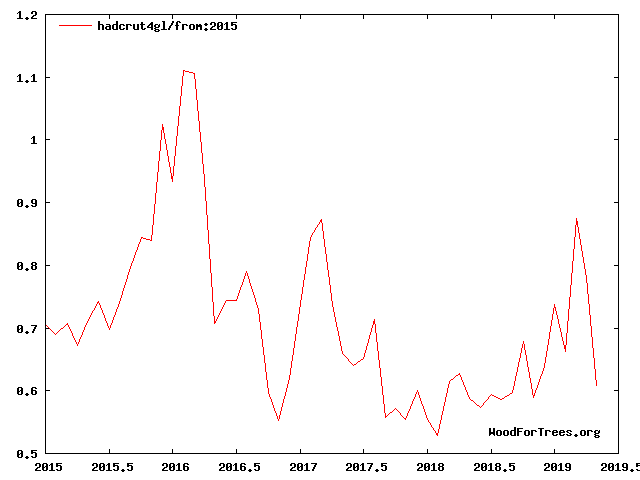Zwischen 1998 und 2015 gab es ein Jahrzehnt, in dem die Temperaturen nicht weiter anstiegen. Die Zeit wurde in der Fachwelt auch „Hiatus“ genannt (Abb. 1) und war Thema zahlreicher Fachpublikationen.

Abbildung 1: Globale Temperaturentwicklung 1998-2015 (HadCRUT). Graphik: Woodfortrees.
Erst der El Nino 2015/16 brachte dann wieder eine Erwärmung. Seit der El Nino-Spitze sacken die Temperaturen aber wieder ab (Abb. 2).

Abbildung 2: Globale Temperaturentwicklung 2015-2019 (HadCRUT). Graphik: Woodfortrees.
Phänologen haben den Hiatus jetzt auch in den Blühzeiten der Pflanzen nachgewiesen. In der Zeit der Erwärmungspause veränderten sich die Blühzeiten kaum, wie eine Studie von Xufeng Wang und Kollegen dokumentiert, die am 3. Juni 2019 in Nature Communications erschien. Hier der dazugehörige Abstract:
No trends in spring and autumn phenology during the global warming hiatus
Phenology plays a fundamental role in regulating photosynthesis, evapotranspiration, and surface energy fluxes and is sensitive to climate change. The global mean surface air temperature data indicate a global warming hiatus between 1998 and 2012, while its impacts on global phenology remains unclear. Here we use long-term satellite and FLUXNET records to examine phenology trends in the northern hemisphere before and during the warming hiatus. Our results based on the satellite record show that the phenology change rate slowed down during the warming hiatus. The analysis of the long-term FLUXNET measurements, mainly within the warming hiatus, shows that there were no widespread advancing (or delaying) trends in spring (or autumn) phenology. The lack of widespread phenology trends partly led to the lack of widespread trends in spring and autumn carbon fluxes. Our findings have significant implications for understanding the responses of phenology to climate change and the climate-carbon feedbacks.
Die University of New Hampshire (UNH) gab dazu die folgende Pressemitteilung heraus:
UNH Researchers Find Slowdown in Earth’s Temps Stabilized Nature’s Calendar
Sometimes referred to as nature’s calendar, phenology looks at the seasonal life cycle of plants and animals and is one of the leading indicators of climate change. It’s the observance of natural occurrences like the first formation of buds and flowers in the spring and the changing colors of leaves in the fall. According to researchers at the University of New Hampshire, when the rate of the Earth’s air temperature slows down for a significant amount of time, so can phenology.
In a study, recently published in the journal Nature Communications, researchers focused on a 15-year period in the early part of this century, when there was a temporary slowdown in the rise of the Earth’s air temperatures. It continued to rise, but more slowly than in the years before and after. Scientists found that during that period, phenology remained relatively constant from year to year, with no appreciable increase in the length of the growing seasons.
“This finding was a big surprise to us because the Earth’s climate is changing and affecting the length of the seasons,” says Jingfeng Xiao, a research associate professor at the UNH Earth Systems Research Center. “Over the past decades we have experienced longer growing seasons, with spring coming earlier and fall coming later, but this wasn’t the situation from 1998 to 2012 in the northern hemisphere.”
Phenology plays a major role in helping to regulate plant photosynthesis, transpiration, and energy exchange. When phenology stabilizes, it’s easier to estimate when to start a garden, when fall foliage will peak and helps life cycles like pollination, migration and mating. Researchers examined the carbon dioxide exchange between plants and the atmosphere from 56 sites located in forests, croplands, savannas, shrublands and grasslands in the northern hemisphere. They were the first to compare those findings with satellite imagery that indicated the dates of leaf-out (when leaves emerge in the spring) and senescence (when leaves fall and plants die off or enter dormancy in autumn) to estimate the length and timing of the growing season, which stayed about the same for that time period.
Earlier leaf-out and/or later senescence can mean a longer growing season, increase in agriculture production and crop yield, as well as an increase in the amount of carbon dioxide absorbed by plants from the atmosphere. However, it can also mean the need for more water use and could affect stream flow and aggravate water crisis issues. “It’s not just about plants, many people are also physically affected by phenological trends,” said Xiao. “Anyone suffering from seasonal allergies knows, an earlier spring, or growing season, can mean an earlier allergy season.”
Phenological variations also make it more difficult for scientists to estimate the Earth’s carbon, water and energy exchange between the atmosphere and the Earth’s surface, which can then affect climate change projections. The scientists admit that the time period they studied, where the Earth’s air temperature rate slowed down, may seem to contrast with other research on global warming but they emphasize that even during this period the Earth’s temperatures continued to rise. They point out that temporary trends like this one require very long datasets — at least a decade or longer — to properly assess big-picture phenological trends.
Funding for this research was provided in part by the National Aeronautics and Space Administration (NASA). The University of New Hampshire inspires innovation and transforms lives in our state, nation and world. More than 16,000 students from all 50 states and 71 countries engage with an award-winning faculty in top-ranked programs in business, engineering, law, health and human services, liberal arts and the sciences across more than 200 programs of study. As one of the nation’s highest-performing research universities, UNH partners with NASA, NOAA, NSF and NIH, and receives more than $110 million in competitive external funding every year to further explore and define the frontiers of land, sea and space.